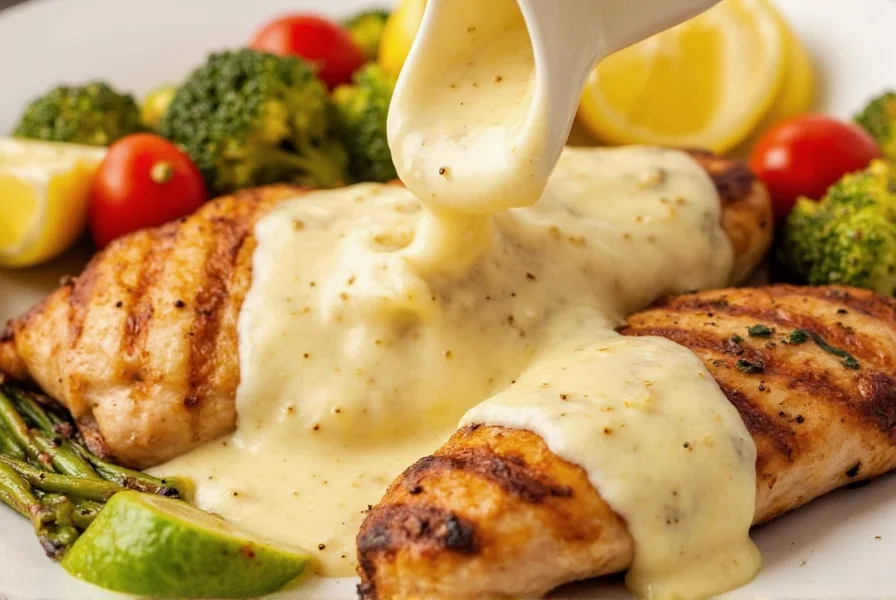The perfect lemon pepper sauce recipe combines 1/2 cup mayonnaise, 2 tablespoons fresh lemon juice, 1 tablespoon lemon zest, 1 teaspoon freshly cracked black pepper, 1/2 teaspoon garlic powder, and 1/4 teaspoon onion powder. Whisk ingredients together until smooth. Chill for 30 minutes before serving. This basic recipe takes just 5 minutes to prepare and yields enough sauce for 4 servings.
Making exceptional lemon pepper sauce doesn't require culinary expertise—just quality ingredients and proper technique. This versatile condiment elevates everything from grilled chicken to roasted vegetables with its bright citrus notes and subtle heat. Unlike store-bought versions filled with preservatives, homemade lemon pepper sauce lets you control the flavor profile and ingredient quality.
Why This Lemon Pepper Sauce Recipe Works
The magic happens through the balance of acidity from fresh lemon juice, aromatic zest, and freshly cracked pepper. Pre-ground pepper loses its volatile oils quickly, resulting in flat flavor. Freshly cracked pepper provides complex floral and pine notes that transform this simple sauce from ordinary to extraordinary.

Essential Ingredients Explained
Understanding each component ensures perfect results every time:
| Ingredient | Function | Substitution |
|---|---|---|
| Mayonnaise (full-fat) | Creates creamy base that emulsifies ingredients | Greek yogurt for lighter version |
| Fresh lemon juice | Provides bright acidity without artificial taste | Bottled juice (less ideal) |
| Lemon zest | Concentrated citrus oil for intense flavor | None—critical for authentic taste |
| Freshly cracked pepper | Complex heat and floral notes | Pre-ground pepper (less flavorful) |
Step-by-Step Preparation Guide
- Zest the lemons: Use a microplane to remove only the yellow zest, avoiding bitter white pith
- Extract juice: Roll lemons firmly on counter before juicing to maximize yield
- Crack pepper: Use coarse grind for optimal flavor release
- Combine ingredients: Whisk mayonnaise, lemon juice, zest, pepper, garlic powder, and onion powder until smooth
- Rest: Refrigerate minimum 30 minutes to allow flavors to meld
- Adjust: Taste before serving and tweak lemon or pepper as needed
Pro Tips for Perfect Results
- Temperature matters: Use room temperature mayonnaise for smoother emulsion
- Freshness is key: Make sauce within 24 hours of zesting lemons for brightest flavor
- Pepper timing: Add pepper just before serving to preserve volatile compounds
- Acidity balance: If too tart, add 1/2 teaspoon honey to counterbalance
Variations to Try
Customize this basic lemon pepper sauce recipe for different applications:
- Creamy version: Add 2 tablespoons sour cream for richer texture
- Lighter option: Substitute half the mayo with Greek yogurt
- Extra zing: Include 1 teaspoon capers for briny complexity
- Spicy kick: Mix in 1/4 teaspoon cayenne pepper
- Herb-infused: Stir in 1 tablespoon chopped dill or parsley

Serving Suggestions
This versatile sauce complements numerous dishes:
- Drizzle over grilled chicken breasts or fish fillets
- Use as dipping sauce for artichokes or asparagus
- Thin with olive oil for vibrant salad dressing
- Spread on sandwiches instead of mayonnaise
- Stir into pasta salad for bright flavor boost
Storage and Shelf Life
Properly stored, homemade lemon pepper sauce maintains quality for:
- Refrigerator: 5-7 days in airtight container
- Freezer: Not recommended (mayonnaise separates)
Always use clean utensils when serving to prevent contamination. The sauce may separate slightly after chilling—simply stir gently before using. Discard if mold appears or if it develops sour smell.
Troubleshooting Common Issues
- Too tart: Balance with 1/2 teaspoon honey or additional mayo
- Too thick: Thin with water or lemon juice, 1 teaspoon at a time
- Flat flavor: Add freshly cracked pepper and zest
- Separated sauce: Whisk vigorously or blend briefly
Frequently Asked Questions
Can I make lemon pepper sauce without mayonnaise?
Yes, substitute mayonnaise with equal parts Greek yogurt or silken tofu blended until smooth. For dairy-free option, use avocado blended with lemon juice and olive oil. Note that texture and shelf life will differ from traditional versions.
How can I make my lemon pepper sauce less spicy?
Reduce black pepper to 1/2 teaspoon and use only freshly cracked pepper (pre-ground is often spicier). Add 1 teaspoon extra lemon zest to maintain flavor complexity without heat. For immediate relief, stir in 1 tablespoon mayonnaise to mellow the spice.
What's the best way to store lemon pepper sauce?
Store in an airtight glass container in the refrigerator for up to 7 days. Press plastic wrap directly onto the sauce surface before sealing to prevent oxidation. Always use clean utensils when serving to maximize freshness. Do not freeze as the emulsion will break.
Why does my homemade sauce taste different from restaurant versions?
Restaurant versions often contain additional ingredients like buttermilk, herbs, or proprietary seasonings. For closer approximation, try adding 1 teaspoon dried dill, 1/2 teaspoon onion powder, and a pinch of cayenne. The key difference is usually the quality of pepper—restaurants typically use premium Tellicherry peppercorns.
Can I use dried lemon zest in this recipe?
Fresh zest provides superior flavor as dried versions lose volatile oils. If absolutely necessary, use 1/4 teaspoon dried lemon zest plus 1 teaspoon extra lemon juice, but expect noticeably less vibrant citrus flavor. Freshly zested lemons make the most significant difference in quality.











 浙公网安备
33010002000092号
浙公网安备
33010002000092号 浙B2-20120091-4
浙B2-20120091-4